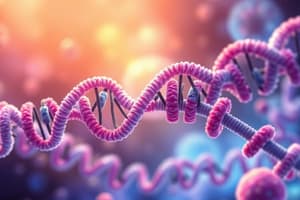Podcast
Questions and Answers
Which organelle is responsible for the process of translation?
Which organelle is responsible for the process of translation?
- Mitochondria
- Endoplasmic Reticulum
- Nucleolus
- Ribosomes (correct)
What type of genetic mutation occurs when a section of a DNA sequence detaches and rejoins in the opposite orientation?
What type of genetic mutation occurs when a section of a DNA sequence detaches and rejoins in the opposite orientation?
- Duplication
- Inversion (correct)
- Deletion
- Substitution
Which of the following is NOT a type of genetic mutation?
Which of the following is NOT a type of genetic mutation?
- Translocation
- Fragmentation (correct)
- Addition
- Substitution
What is the process by which the sequence of a messenger RNA (mRNA) molecule is translated into a sequence of amino acids during protein synthesis?
What is the process by which the sequence of a messenger RNA (mRNA) molecule is translated into a sequence of amino acids during protein synthesis?
Which type of genetic mutation involves the addition of one or more nucleotide base pairs into a DNA sequence?
Which type of genetic mutation involves the addition of one or more nucleotide base pairs into a DNA sequence?
Which organelle is responsible for the process of transcription?
Which organelle is responsible for the process of transcription?
What are the two types of nitrogenous bases found in DNA?
What are the two types of nitrogenous bases found in DNA?
What is the difference between a dominant trait and a recessive trait?
What is the difference between a dominant trait and a recessive trait?
What is the process by which the sequence of nucleotides in DNA is used to guide the synthesis of a protein called?
What is the process by which the sequence of nucleotides in DNA is used to guide the synthesis of a protein called?
Which of the following is NOT a type of genetic mutation?
Which of the following is NOT a type of genetic mutation?
What is the role of the enzyme RNA polymerase in the process of transcription?
What is the role of the enzyme RNA polymerase in the process of transcription?
Which of the following best describes the structure of DNA?
Which of the following best describes the structure of DNA?
Which of the following statements about DNA replication is true?
Which of the following statements about DNA replication is true?
What is the process by which the information in DNA is used to produce a functional protein?
What is the process by which the information in DNA is used to produce a functional protein?
Which of the following statements about genetic mutations is correct?
Which of the following statements about genetic mutations is correct?
What is the process by which the information in a DNA strand is copied into a new molecule of messenger RNA (mRNA)?
What is the process by which the information in a DNA strand is copied into a new molecule of messenger RNA (mRNA)?
Which of the following is NOT one of the steps in the central dogma of life, as described in the text?
Which of the following is NOT one of the steps in the central dogma of life, as described in the text?
What are the two main types of mutations?
What are the two main types of mutations?
Flashcards are hidden until you start studying




